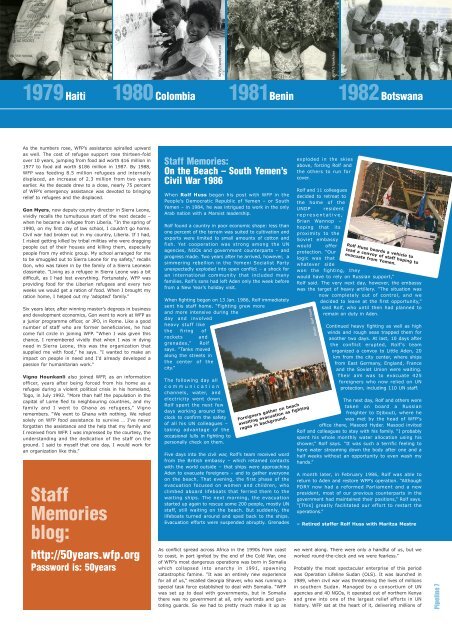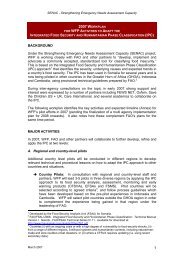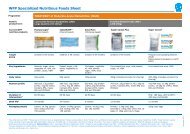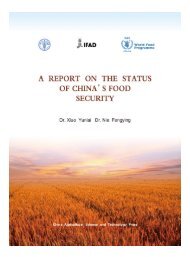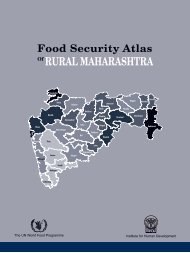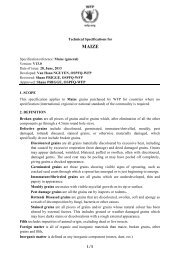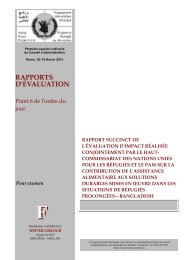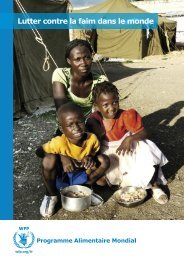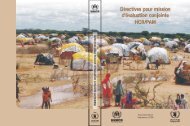Pipeline 50 Years - WFP Remote Access Secure Services
Pipeline 50 Years - WFP Remote Access Secure Services
Pipeline 50 Years - WFP Remote Access Secure Services
- No tags were found...
You also want an ePaper? Increase the reach of your titles
YUMPU automatically turns print PDFs into web optimized ePapers that Google loves.
<strong>WFP</strong>/Franco Mattioli<strong>WFP</strong>/Franco Mattioli<strong>WFP</strong>/J VanAcker<strong>WFP</strong>/Franco Mattioli1979 1980 1982 Haiti Colombia 1981BeninBotswanaAs the numbers rose, <strong>WFP</strong>’s assistance spiralled upwardas well. The cost of refugee support rose thirteen-foldover 10 years, jumping from food aid worth $16 million in1977 to food aid worth $186 million in 1987. By 1988,<strong>WFP</strong> was feeding 8.5 million refugees and internallydisplaced, an increase of 2.3 million from two yearsearlier. As the decade drew to a close, nearly 75 percentof <strong>WFP</strong>’s emergency assistance was devoted to bringingrelief to refugees and the displaced.Gon Myers, now deputy country director in Sierra Leone,vividly recalls the tumultuous start of the next decade –when he became a refugee from Liberia. “In the spring of1990, on my first day of law school, I couldn't go home.Civil war had broken out in my country, Liberia. If I had,I risked getting killed by tribal militias who were draggingpeople out of their houses and killing them, especiallypeople from my ethnic group. My school arranged for meto be smuggled out to Sierra Leone for my safety,” recallsGon, who was taken in by the family of a Sierra Leoneanclassmate. “Living as a refugee in Sierra Leone was a bitdifficult, as I had lost everything. Fortunately, <strong>WFP</strong> wasproviding food for the Liberian refugees and every twoweeks we would get a ration of food. When I brought myration home, I helped out my 'adopted' family.”Six years later, after winning master’s degrees in businessand development economics, Gon went to work at <strong>WFP</strong> asa junior programme officer, or JPO, in Rome. Like a goodnumber of staff who are former beneficiaries, he hadcome full circle in joining <strong>WFP</strong>. “When I was given thischance, I remembered vividly that when I was in dyingneed in Sierra Leone, this was the organization thatsupplied me with food,” he says. “I wanted to make animpact on people in need and I'd already developed apassion for humanitarian work.”Vigno Hounkanli also joined <strong>WFP</strong>, as an informationofficer, years after being forced from his home as arefugee during a violent political crisis in his homeland,Togo, in July 1992. “More than half the population in thecapital of Lome fled to neighbouring countries, and myfamily and I went to Ghana as refugees,” Vignoremembers. “We went to Ghana with nothing. We reliedsolely on <strong>WFP</strong> food assistance to survive … I’ve neverforgotten the assistance and the help that my family andI received from <strong>WFP</strong>. I was impressed by the courtesy, theunderstanding and the dedication of the staff on theground. I said to myself that one day, I would work foran organization like this.”StaffMemoriesblog:http://<strong>50</strong>years.wfp.orgPassword is: <strong>50</strong>yearsStaff Memories:On the Beach – South Yemen’sCivil War 1986When Rolf Huss began his post with <strong>WFP</strong> in thePeople’s Democratic Republic of Yemen – or SouthYemen – in 1984, he was intrigued to work in the onlyArab nation with a Marxist leadership.Rolf found a country in poor economic shape: less thanone percent of the terrain was suited to cultivation andexports were limited to small amounts of cotton andfish. Yet cooperation was strong among the UNagencies, NGOs and government counterparts – andprogress made. Two years after he arrived, however, asimmering rebellion in the Yemeni Socialist Partyunexpectedly exploded into open conflict – a shock foran international community that included manyfamilies. Rolf’s sons had left Aden only the week beforefrom a New Year’s holiday visit.When fighting began on 13 Jan. 1986, Rolf immediatelysent his staff home. “Fighting grew moreand more intensive during theday and involvedheavy stuff likethe firing ofrockets andgrenades,” Rolfsays. “Tanks movedalong the streets inthe center of thecity.”The following day allc o m m u n i c a t i o nchannels, water, andelectricity went down.Rolf spent the next fewdays working around theclock to confirm the safetyof all his UN colleagues –taking advantage of theoccasional lulls in fighting topersonally check on them.Five days into the civil war, Rolf’s team received wordfrom the British embassy – which retained contactswith the world outside – that ships were approachingAden to evacuate foreigners – and to gather everyoneon the beach. That evening, the first phase of theevacuation focused on women and children, whoclimbed aboard lifeboats that ferried them to thewaiting ships. The next morning, the evacuationstarted up again to rescue some 200 people, mostly UNstaff, still waiting on the beach. But suddenly, thelifeboats turned around and sped back to the ships.Evacuation efforts were suspended abruptly. GrenadesAs conflict spread across Africa in the 1990s from coastto coast, in part ignited by the end of the Cold War, oneof <strong>WFP</strong>’s most dangerous operations was born in Somaliawhich collapsed into anarchy in 1991, spawningcatastrophic famine. “It was an entirely new experiencefor all of us,” recalled Georgia Shaver, who was running aspecial task force established to deal with Somalia. “<strong>WFP</strong>was set up to deal with governments, but in Somaliathere was no government at all, only warlords and guntotingguards. So we had to pretty much make it up asexploded in the skiesabove, forcing Rolf andthe others to run forcover.Rolf and 11 colleaguesdecided to retreat tothe home of theUNDP residentr e p r e s e n t a t i v e ,Brian Wannop –hoping that itsproximity to theSoviet embassywould offerprotection. “Ourlogic was thatwhatever sidewon the fighting, theywould have to rely on Russian support,”Rolf said. The very next day, however, the embassywas the target of heavy artillery. “The situation wasnow completely out of control, and wedecided to leave at the first opportunity,”said Rolf, who until then had planned toremain on duty in Aden.Photo: Rolf HussForeigners gather on beachawaiting evacuation as fightingrages in background.Rolf Huss boards a vehicle tolead a convoy of staff hoping toevacuate from Yemen.Continued heavy fighting as well as highwinds and rough seas trapped them foranother two days. At last, 10 days afterthe conflict erupted, Rolf’s teamorganized a convoy to Little Aden, 20km from the city center, where shipsfrom East Germany, England, Franceand the Soviet Union were waiting.Their aim was to evacuate 425foreigners who now relied on UNprotection, including 110 UN staff.The next day, Rolf and others weretaken on board a Russianfreighter to Djibouti, where hewas met by the head of <strong>WFP</strong>’soffice there, Masood Hyder. Masood invitedRolf and colleagues to stay with his family. “I probablyspent his whole monthly water allocation using hisshower,” Rolf says. “It was such a terrific feeling tohave water streaming down the body after one and ahalf weeks without an opportunity to even wash myhands.”A month later, in February 1986, Rolf was able toreturn to Aden and restore <strong>WFP</strong>’s operation. “AlthoughPDRY now had a reformed Parliament and a newpresident, most of our previous counterparts in thegovernment had maintained their positions,” Rolf says.“[This] greatly facilitated our effort to restart theoperations.”– Retired staffer Rolf Huss with Maritza Mestrewe went along. There were only a handful of us, but weworked round-the-clock and we were fearless.”Probably the most spectacular enterprise of this periodwas Operation Lifeline Sudan (OLS). It was launched in1989, when civil war was threatening the lives of millionsin southern Sudan. Managed by a consortium of UNagencies and 40 NGOs, it operated out of northern Kenyaand grew into one of the largest relief efforts in UNhistory. <strong>WFP</strong> sat at the heart of it, delivering millions of<strong>Pipeline</strong> 7


